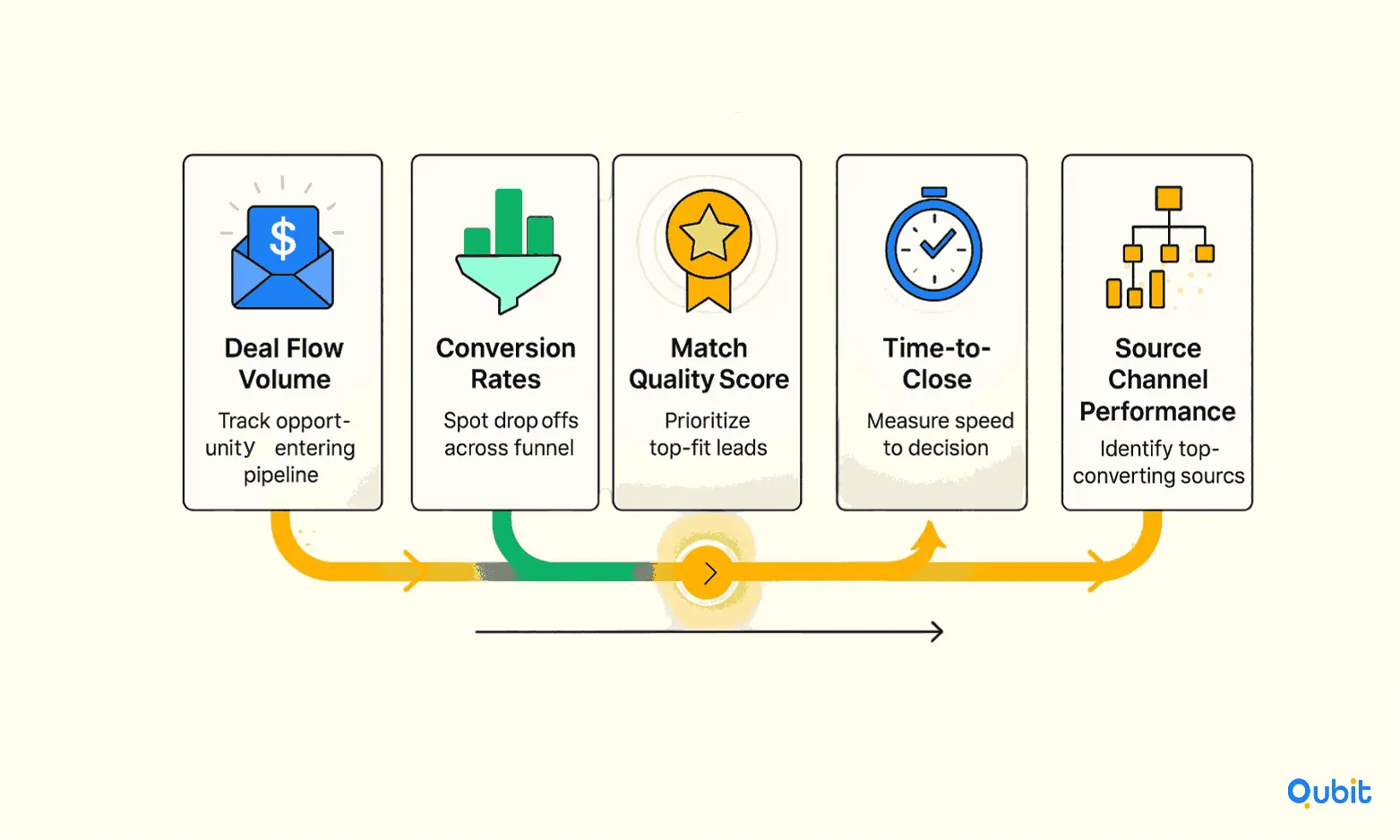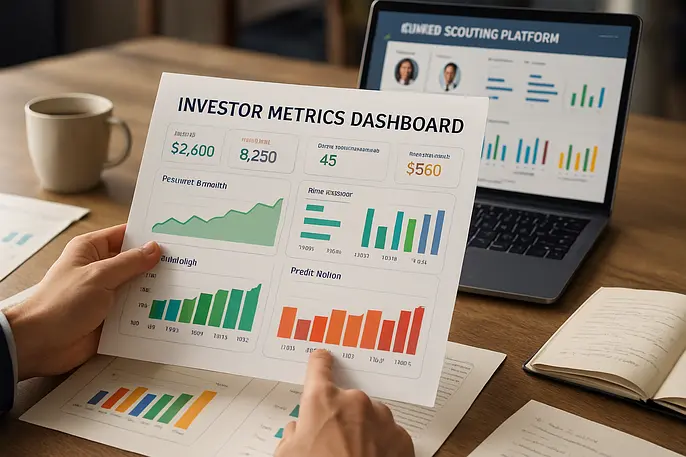The global deal origination market, valued at $4.4 billion in 2023, underscores the growing importance of data-driven strategies in venture capital decision-making. Investors are increasingly relying on quantitative metrics to evaluate startup opportunities, ensuring that every scouting effort aligns with their financial goals. This blog aims to provide a comprehensive framework for measuring the success of startup scouting initiatives, focusing on actionable metrics and advanced tools.
The detailed breakdown of fiscal parameters complements your discussion, as financial metrics for startup investment offer a closer look at the numbers behind valuation decisions. By integrating these insights, investors can refine their approach to deal sourcing and maximize returns. Let’s explore how data-backed strategies can transform scouting into a measurable success.
Deal Sourcing Metrics and Tracking
Quantifying deal sourcing efforts is essential for optimizing investment pipelines and making informed decisions. Metrics such as deal flow volume, conversion rates, match quality scores, time-to-close, and deal source performance provide actionable insights into the efficiency and effectiveness of sourcing strategies. Venture capital firms, for instance, evaluate an average of 101 opportunities before closing a single deal, emphasizing the need for robust tracking systems to streamline this process.

Key Metrics to Monitor
1. Deal Flow Volume
Tracking the number of opportunities entering the pipeline is the first step in assessing sourcing efficiency. A high deal flow volume indicates strong outreach and visibility, but it’s equally important to evaluate the quality of these leads. Tools like spreadsheets can be used to manually capture and report deal flow data, ensuring accurate volume metrics.
2. Conversion Rates
Conversion rates measure the percentage of deals that progress through each stage of the pipeline. Identifying bottlenecks in the funnel can help refine screening processes and improve overall efficiency. Dedicated software solutions are particularly useful for analyzing conversion rates, as they flag areas where deals may stall or drop off.
3. Match Quality Scores
Match quality scores assess how well a potential deal aligns with investment criteria. This metric helps prioritize high-value opportunities and reduce wasted time on mismatched leads. Advanced analytics tools can automate this scoring process, ensuring consistency and accuracy.
4. Time-to-Close
Time-to-close tracks the duration from initial contact to deal closure. Shorter timelines often indicate streamlined processes and effective communication. A robust CRM solution can significantly reduce time-to-close by automating follow-up reminders and centralizing key data.
5. Deal Source Performance
Evaluating the performance of various deal sources, such as referrals, direct outreach, or inbound inquiries—helps identify the most productive channels. Segment, a tool designed to unify multiple data sources, can reduce manual errors in reporting and provide real-time insights into source effectiveness.
The Role of Advanced Analytics and Automation
The growing trend toward automation in deal sourcing is transforming pipeline management. Automated CRM workflows and AI-driven analytics not only improve conversion rates but also save time. Research shows that firms adopting these technologies experience up to 30% higher deal origination rates and 40% time savings. Automation also minimizes human error, ensuring more reliable data for decision-making.
Connecting Metrics to Broader Strategies
Integrating deal sourcing metrics with overarching strategies, such as startup scouting strategies, ensures a cohesive approach to evaluating early-stage ventures. This alignment helps firms focus on opportunities that align with their long-term goals while maintaining a streamlined pipeline.
By focusing on these metrics and embracing automation, firms can enhance their sourcing strategies and make more confident investment decisions.
Deal Sourcing Strategies and Platforms
Identifying the right deals is a cornerstone of successful investment strategies, and the methods for sourcing these opportunities have evolved significantly. From cutting-edge AI-driven platforms to tried-and-true networking approaches, investors today have access to a diverse set of tools and techniques to streamline their processes.
1. AI-Driven Platforms: Revolutionizing Deal Sourcing
Artificial intelligence has transformed how deals are identified and assessed. Modern AI tools analyze vast datasets to uncover patterns, predict market trends, and highlight opportunities that might otherwise go unnoticed. These platforms not only save time but also enhance accuracy, enabling investors to focus on high-potential prospects.
For example, AI-driven platforms can evaluate startup user growth metrics to identify businesses with strong customer acquisition and retention patterns. Insights into startup user growth metrics can complement your deal sourcing strategy, offering a practical lens to assess engagement and scalability.
2. Traditional Networking: The Human Element
While technology has accelerated deal sourcing, traditional networking remains indispensable. Building relationships through industry events, conferences, and personal connections often leads to exclusive opportunities that are not publicly listed. These interactions foster trust and provide deeper insights into the people behind the ventures.
Networking also allows investors to tap into their existing networks for referrals, which can be particularly valuable in venture capital and private equity. The human element of deal sourcing ensures that qualitative factors, such as team dynamics and leadership potential, are not overlooked.
3. Venture Capital and Private Equity Approaches
Venture capitalists often focus on early-stage startups, relying on a mix of technology and personal connections to identify promising businesses. Private equity firms, on the other hand, typically target more mature companies, using detailed financial analysis and industry-specific insights to pinpoint opportunities.
Both approaches benefit from integrating technology to streamline processes. In fact, technology integration has boosted deal execution speed by approximately 13% in certain verticals, allowing firms to act quickly on high-value opportunities.
4. Online Deal Sourcing Tools: Speed and Accessibility
Online platforms have democratized deal sourcing, making it easier for investors to access a global pool of opportunities. These tools offer features like advanced filtering, real-time updates, and direct communication channels, enabling rapid evaluation and decision-making.
For instance, startup scouting platforms like Qubit which can provide curated lists of businesses aligned with specific investment criteria. This accessibility ensures that investors can stay ahead in competitive markets without sacrificing thoroughness.
Balancing Technology and Tradition
The most effective deal sourcing strategies often combine modern technology with traditional methods. AI tools and online platforms provide efficiency and scalability, while networking and personal connections add depth and context. By blending these approaches, investors can maximize their chances of identifying and securing high-quality deals.
Key Steps in the Deal Sourcing Process
A structured approach to deal sourcing typically involves the following steps:
Defining Investment Criteria
Investors begin by outlining their objectives, including preferred industries, company sizes, and financial metrics. Clear criteria streamline the process and ensure alignment with long-term goals.Identifying Opportunities
This step involves leveraging multiple channels such as industry networks, online platforms, and referrals to uncover potential deals. Creativity and persistence are essential here.Evaluating Prospects
Once opportunities are identified, they are assessed against predefined criteria. This includes analyzing financial statements, market positioning, and growth potential.Building Relationships
Establishing trust with business owners and stakeholders is crucial. Strong relationships often lead to exclusive opportunities and smoother negotiations.Closing the Deal
The final step involves due diligence, valuation, and negotiation to finalize the investment.
Methods to Evaluate Opportunities
Evaluating opportunities effectively requires a combination of quantitative and qualitative analysis:
Quantitative Analysis: This includes reviewing financial metrics such as revenue growth, profitability, and cash flow.
Qualitative Analysis: Factors like market trends, competitive positioning, and management team expertise are equally important.
For a deeper understanding of operational challenges, the examination of churn rate benchmarks for startups can offer valuable insights. These benchmarks provide a nuanced perspective on patterns that might signal early issues.
Strategies to Improve Deal Sourcing Skills
Continuous improvement is key to mastering deal sourcing. Here are some strategies to enhance your skills:
Expand Your Network
Attend industry events, join professional associations, and actively engage with peers to uncover new opportunities.Stay Informed
Keep up with market trends and emerging industries to identify areas of growth.Leverage Technology
Utilize deal sourcing platforms and data analytics tools to streamline the process and uncover hidden opportunities.Learn from Experience
Analyze past deals to identify what worked and what didn’t. Use these insights to refine your approach.
Conclusion
A well-rounded investment strategy thrives on the balance between traditional methods and technology-driven deal sourcing. By focusing on quantifiable metrics, investors can make informed decisions that minimize risks and maximize opportunities. Building a robust scouting process, supported by data-driven insights, ensures that every opportunity is evaluated with precision and clarity.
At Qubit Capital, we understand the importance of connecting investors with the right startups. If you're ready to explore breakthrough opportunities, our Startup Matchmaking service is here to help. Let’s get started!
Key Takeaways
- Quantitative metrics are essential to optimizing deal sourcing and pipeline management.
- Advanced analytics and automation can significantly improve deal origination efficiency and reduce processing time.
- A balanced strategy combining traditional networking with modern, digital sourcing methods yields the best investment results.
- A structured, data-driven approach helps investors identify the most promising startups.
- Integrating AI tools and robust digital platforms is key to reducing time-to-close and enhancing overall screening accuracy.
Frequently asked Questions
What are the key metrics for deal sourcing?
Key metrics include deal flow volume, conversion rates, match quality scores, time-to-close, and deal source performance, all of which help streamline the investment decision process.






